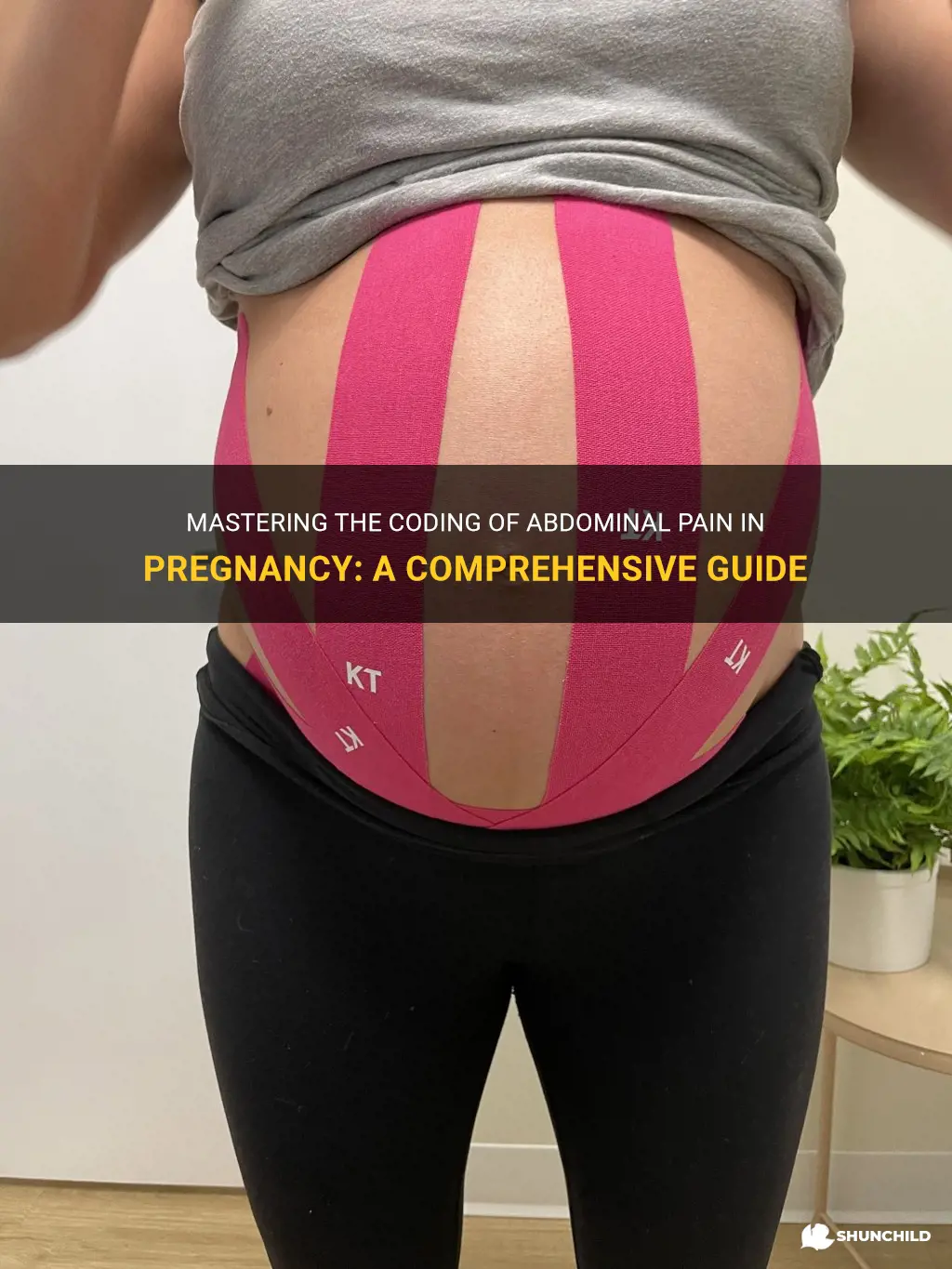
Abdominal pain during pregnancy can be a common and often normal occurrence, but it can also be a sign of a more serious condition. Properly coding and documenting abdominal pain in pregnancy is crucial for accurate diagnosis and optimal patient care. In this article, we will delve into the various causes and coding guidelines for abdominal pain in pregnancy, providing valuable insights for healthcare providers and medical coders alike.
| Characteristics | Values |
|---|---|
| Location | Abdomen |
| Quality | Sharp, dull |
| Severity | Mild, moderate, severe |
| Onset | Sudden, gradual |
| Duration | Brief, constant |
| Aggravating Factors | Movement, eating |
| Alleviating Factors | Rest, changing positions |
| Associated Symptoms | Nausea, vomiting |
| Medical History | Previous C-section, fibroids |
| Obstetric History | Multiparity, preterm labor |
| Exams and Tests | Pregnancy test, ultrasound |
| Treatment | Pain medications, ointments |
What You'll Learn
- What are the specific ICD-10 codes for coding abdominal pain in pregnancy?
- Are there any additional guidelines or documentation requirements for coding abdominal pain in pregnancy?
- How should abdominal pain in early pregnancy be coded differently from abdominal pain in later stages of pregnancy?
- Are there any specific coding rules or conventions for coding abdominal pain in high-risk pregnancies or complications?
- What are some common causes of abdominal pain in pregnancy that should be documented and coded accurately?

What are the specific ICD-10 codes for coding abdominal pain in pregnancy?
Abdominal pain is a common complaint during pregnancy, with a variety of potential causes. When coding abdominal pain in pregnancy, it is important to use the appropriate ICD-10 codes to ensure accurate documentation and reimbursement. This article will provide an overview of the specific ICD-10 codes for coding abdominal pain in pregnancy.
ICD-10, which stands for the International Classification of Diseases, 10th Revision, is a standardized system used by healthcare professionals for coding medical diagnoses. The system is constantly updated to reflect advances in medical knowledge and provide specific codes for different conditions and symptoms.
To accurately code abdominal pain in pregnancy, it is essential to first identify the underlying cause. Some common causes of abdominal pain during pregnancy include:
- Round ligament pain: This is a common cause of abdominal pain during pregnancy, characterized by a sharp or stabbing pain on one or both sides of the lower abdomen. The ICD-10 code for round ligament pain in pregnancy is O26.82.
- Gastrointestinal disorders: Conditions such as gastroenteritis, constipation, and irritable bowel syndrome can cause abdominal pain during pregnancy. The specific ICD-10 codes for gastrointestinal disorders vary depending on the specific condition. For example, the code for gastroenteritis during pregnancy is O98.3, while the code for intestinal obstruction during pregnancy is O91.3.
- Urinary tract infections: Urinary tract infections (UTIs) are common during pregnancy and can cause lower abdominal pain. The ICD-10 code for UTIs during pregnancy is O23.40.
- Ectopic pregnancy: An ectopic pregnancy occurs when the fertilized egg implants outside the uterus, usually in the fallopian tube. It can cause severe abdominal pain and is considered a medical emergency. The ICD-10 code for ectopic pregnancy is O00.9.
- Placental disorders: Conditions such as placental abruption or placenta previa can cause abdominal pain during pregnancy. The specific ICD-10 codes for these conditions depend on the severity and specific diagnosis.
- Preterm labor: Abdominal pain can be a symptom of preterm labor, which occurs before 37 weeks of gestation. The ICD-10 code for preterm labor is O60.0.
When coding abdominal pain in pregnancy, it is crucial to include additional information to further specify the diagnosis. For example, if a patient presents with abdominal pain due to constipation, the ICD-10 code O98.1 (Constipation complicating pregnancy) can be used. Similarly, if a patient presents with abdominal pain due to gastritis, the ICD-10 code O98.5 (Gastritis complicating pregnancy) can be used.
In addition to coding the underlying cause of abdominal pain, it is essential to include any associated symptoms or complications when appropriate. This ensures accurate documentation and allows for proper medical management and reimbursement.
In summary, there are specific ICD-10 codes for coding abdominal pain in pregnancy, depending on the underlying cause. It is crucial to identify the specific condition causing the abdominal pain and use the appropriate ICD-10 code to ensure accurate documentation and reimbursement. Including additional information such as associated symptoms or complications further specifies the diagnosis and aids in proper medical management.
Is Consuming Excessive Shrimp Harmful During Pregnancy?
You may want to see also

Are there any additional guidelines or documentation requirements for coding abdominal pain in pregnancy?
When it comes to coding abdominal pain in pregnancy, there are indeed additional guidelines and documentation requirements that need to be followed. Coding for abdominal pain in pregnancy requires a thorough understanding of both obstetric coding guidelines and abdominal pain coding guidelines. In this article, we will discuss the necessary steps and documentation requirements for coding abdominal pain in pregnancy.
Step 1: Understanding Obstetric Coding Guidelines
Coding for abdominal pain in pregnancy falls under the category of obstetric coding. It is crucial to have a good grasp of the relevant obstetric coding guidelines, such as the International Classification of Diseases, Tenth Revision (ICD-10) Obstetric Guidelines. These guidelines provide specific information on how to code for pregnancy-related conditions, including abdominal pain.
Step 2: Classify the Abdominal Pain
The first step in coding abdominal pain in pregnancy is to classify the type of pain. Abdominal pain can be classified as acute or chronic, and further categorized as nonspecific or specific. Acute abdominal pain refers to sudden, severe pain, whereas chronic abdominal pain refers to long-lasting or recurring pain. Nonspecific abdominal pain does not have a definite cause, while specific abdominal pain is caused by a known condition or event.
Step 3: Determine the Cause of Abdominal Pain
Once the type of abdominal pain is determined, it is essential to identify the underlying cause. The cause could vary from normal physiological changes in pregnancy to a specific condition requiring medical intervention. Common causes of abdominal pain in pregnancy include round ligament pain, uterine contractions, urinary tract infection, preterm labor, and placental abruption, among others.
Step 4: Assign the Appropriate Diagnosis Codes
After identifying the cause of abdominal pain, the next step is to assign the appropriate diagnosis codes. The ICD-10 coding system provides specific codes for pregnancy-related conditions and abdominal pain. The coding should accurately reflect the cause and type of abdominal pain, as well as any associated conditions or complications.
Step 5: Documenting the Details
Accurate and detailed documentation is crucial for coding abdominal pain in pregnancy. Physicians should document the type of pain, its location, severity, duration, aggravating and relieving factors, associated symptoms, and any other relevant information. Detailed documentation helps ensure accurate coding and provides a clear picture of the patient's condition.
Example:
A pregnant patient presents to the emergency department with severe lower abdominal pain that started suddenly. After a thorough examination, the physician diagnoses the patient with round ligament pain, which is a common cause of abdominal pain in pregnancy. The physician documents the following details in the patient's medical record:
"Patient presents with acute onset of severe lower abdominal pain, localized to the right side. Pain is exacerbated with movement and relieved by rest. No vaginal bleeding or other associated symptoms. Diagnosis of round ligament pain confirmed based on physical examination findings."
Based on the physician's documentation, the appropriate diagnosis code would be O26.849 - Round ligament pain complicating pregnancy.
In conclusion, coding abdominal pain in pregnancy requires adherence to obstetric coding guidelines and thorough documentation. It is crucial to classify the type of pain, determine the cause, and assign the appropriate diagnosis codes. Detailed documentation is essential for accurate coding and proper understanding of the patient's condition. By following these steps and requirements, healthcare professionals can ensure accurate and effective coding of abdominal pain in pregnancy.
How to Alleviate Pain from Swollen Feet During Pregnancy
You may want to see also

How should abdominal pain in early pregnancy be coded differently from abdominal pain in later stages of pregnancy?
When coding abdominal pain in early pregnancy compared to later stages of pregnancy, there are key differences to consider due to the physiological changes that occur throughout pregnancy. This article will guide you on how to accurately code abdominal pain in early and late pregnancy based on the appropriate ICD-10-CM codes.
Understanding the physiological changes in early pregnancy:
During early pregnancy, the uterus starts to expand as the fetus grows. This expansion can cause stretching and pulling sensations in the lower abdomen, which are considered normal. To code abdominal pain in this stage, it is essential to differentiate between normal stretching sensations and signs of potential complications.
Coding abdominal pain in early pregnancy:
When a patient experiences abdominal pain in early pregnancy without any signs of complications or abnormalities, it is appropriate to use the code O99.4 - Diseases of the digestive system complicating pregnancy, childbirth, and the puerperium. Further specificity can be achieved by using additional codes to identify the cause of abdominal pain if known (e.g., gastritis, urinary tract infection, etc.).
Understanding the physiological changes in later stages of pregnancy:
As pregnancy progresses, the uterus continues to expand, putting more pressure on surrounding organs. This increased pressure can lead to various types of abdominal pain, including round ligament pain, Braxton Hicks contractions, and even labor contractions. Differentiating between these types of pain is crucial for accurate coding.
Coding abdominal pain in later stages of pregnancy:
For abdominal pain in late pregnancy, it is important to identify the type of pain being experienced. Round ligament pain, which is the stretching of the ligaments supporting the uterus, can be coded using the code O26.82 - Round ligament pain. Similarly, Braxton Hicks contractions can be coded using the code O47.9 - False labor, unspecified.
Coding abdominal pain with complications in later stages of pregnancy:
If the abdominal pain in later pregnancy is associated with complications, such as placental abruption or preterm labor, additional codes are required to accurately represent the condition. These complications may have specific codes to ensure proper documentation and billing.
Example:
A pregnant patient presents with severe abdominal pain in the lower abdomen during the first trimester. After a thorough examination, it is determined that the pain is due to a urinary tract infection (UTI). In this case, coding for the abdominal pain would include the following codes:
- O99.4 - Diseases of the digestive system complicating pregnancy, childbirth, and the puerperium.
- N39.0 - Urinary tract infection, site not specified.
In another scenario, a pregnant patient at 35 weeks gestation presents with sharp abdominal pain in the lower abdomen, especially on movement. After evaluating the patient, it is determined that the pain is attributed to round ligament pain. The appropriate code for this scenario would be:
O26.82 - Round ligament pain.
In conclusion, coding abdominal pain in early and late pregnancy requires understanding the physiological changes that occur and appropriately differentiating between normal sensations and potential complications. By using the appropriate ICD-10-CM codes, healthcare professionals can accurately document and bill for these conditions, ensuring proper care and reimbursement.
Do I Need to Go to the Doctor for Rib Pain During Pregnancy?
You may want to see also

Are there any specific coding rules or conventions for coding abdominal pain in high-risk pregnancies or complications?
When coding abdominal pain in high-risk pregnancies or complications, there are specific coding rules and conventions that should be followed to ensure accurate documentation and billing. These guidelines are essential for proper communication between healthcare providers, insurance companies, and other entities involved in the healthcare process. In this article, we will explore the coding rules and conventions for abdominal pain in high-risk pregnancies or complications step-by-step, while providing examples to clarify the concepts.
Step 1: Identify the Correct Code Range
The first step in coding abdominal pain in high-risk pregnancies or complications is to identify the correct code range based on the specific condition or complication present. In the International Classification of Diseases, Tenth Revision, Clinical Modification (ICD-10-CM), there are multiple code ranges related to high-risk pregnancies and complications.
For example, if the abdominal pain is due to preeclampsia, the appropriate code range would likely be O11-O14. If the abdominal pain is due to placental abruption, the code range would likely be O45-O49. It is important to consult the ICD-10-CM code set and guidelines to ensure accurate coding.
Step 2: Specify the High-Risk Pregnancy or Complication
Once the correct code range has been identified, it is important to specify the high-risk pregnancy or complication that is causing the abdominal pain. This helps to provide additional information regarding the severity and complexity of the condition.
For example, if the abdominal pain is due to preeclampsia, it would be important to specify if it is mild, severe, or with HELLP syndrome (hemolysis, elevated liver enzymes, low platelet count). This level of detail is essential for accurate coding and appropriate reimbursement.
Step 3: Document the Cause of the Abdominal Pain
In addition to specifying the high-risk pregnancy or complication, it is important to document the cause of the abdominal pain, if known. There may be multiple factors contributing to the abdominal pain, and documenting the cause helps to provide a complete picture of the patient's condition.
For example, if the abdominal pain is due to placental abruption, the cause may be trauma, hypertension, or other factors. Documenting the cause helps to ensure accurate coding and proper reimbursement.
Step 4: Follow Additional Coding Guidelines
In addition to the specific coding rules mentioned above, there are additional coding guidelines that should be followed when coding abdominal pain in high-risk pregnancies or complications. These guidelines are outlined in the ICD-10-CM code set and include instructions on specific qualifiers and sequencing rules.
For example, if the abdominal pain is due to a complication of pregnancy, such as preeclampsia, the coding guidelines recommend using an additional code to identify the specific complication. Additionally, sequencing rules may dictate the order in which the codes should be listed on the claim form.
Examples:
- A pregnant patient presents with severe abdominal pain and is diagnosed with preeclampsia with HELLP syndrome. The appropriate codes for this case would be O14.12 for severe preeclampsia and O14.22 for preeclampsia with HELLP syndrome.
- A pregnant patient presents with sudden onset abdominal pain and is diagnosed with placental abruption due to trauma. The appropriate codes for this case would be O45.9 for unspecified placental abruption and S39.92XA for initial encounter of injury of unspecified intrathoracic organ(s) due to trauma.
In conclusion, when coding abdominal pain in high-risk pregnancies or complications, it is important to follow specific coding rules and conventions to ensure accurate documentation and billing. By correctly identifying the code range, specifying the high-risk pregnancy or complication, documenting the cause of the abdominal pain, and following additional coding guidelines, healthcare providers can accurately communicate the severity and complexity of the patient's condition while maximizing reimbursement.
Relieving Heel Pain During Pregnancy: Effective Tips and Remedies
You may want to see also

What are some common causes of abdominal pain in pregnancy that should be documented and coded accurately?
Abdominal pain is a common symptom experienced by many pregnant women. While most cases of abdominal pain are not serious and resolve on their own, it is important for healthcare professionals to accurately document and code the underlying cause of abdominal pain in pregnancy. This documentation is crucial for accurate diagnosis and appropriate treatment. In this article, we will discuss some common causes of abdominal pain in pregnancy that should be documented and coded accurately.
- Round ligament pain: Round ligament pain is a common cause of abdominal pain during pregnancy, especially in the second trimester. It occurs due to the stretching and thinning of the round ligaments that support the uterus. This pain is usually sharp and tends to be on one side of the abdomen. Accurate documentation and coding of round ligament pain can help differentiate it from other causes of abdominal pain and avoid unnecessary investigations.
- Braxton Hicks contractions: Braxton Hicks contractions are also known as "practice contractions" or "false labor." These contractions cause tightening of the uterus and can often be mistaken for abdominal pain. Accurate documentation and coding of Braxton Hicks contractions can help differentiate them from true labor contractions and prevent unnecessary interventions.
- Gastrointestinal issues: Pregnancy can lead to various changes in the digestive system, including slowed digestion and increased levels of hormones that relax the muscles in the gastrointestinal tract. These changes can result in abdominal pain and discomfort. Common gastrointestinal issues that may cause abdominal pain in pregnancy include constipation, acid reflux, and gallbladder problems. Accurate documentation and coding of these issues can aid in appropriate management and treatment.
- Urinary tract infections: Urinary tract infections (UTIs) are more common during pregnancy due to changes in the urinary system and hormonal fluctuations. UTIs can cause abdominal pain, along with other symptoms such as burning sensation during urination and frequent urination. Accurate documentation and coding of UTIs in pregnancy can help ensure timely and appropriate treatment to prevent complications.
- Ectopic pregnancy: Ectopic pregnancy is a potentially life-threatening condition where the fertilized egg implants outside the uterus, most commonly in the fallopian tubes. Abdominal pain, often accompanied by vaginal bleeding, is a common symptom of ectopic pregnancy. Accurate documentation and coding of ectopic pregnancy are crucial for prompt diagnosis and management.
In conclusion, accurate documentation and coding of the causes of abdominal pain in pregnancy are essential for proper diagnosis and treatment. Common causes that should be documented and coded accurately include round ligament pain, Braxton Hicks contractions, gastrointestinal issues, urinary tract infections, and ectopic pregnancy. By accurately documenting and coding these causes, healthcare professionals can ensure the best care and management for pregnant women experiencing abdominal pain.
Effective Methods to Alleviate Tailbone Pain During Pregnancy
You may want to see also
Frequently asked questions
When the cause of abdominal pain in pregnancy is unknown, you would use the code O26.899. This code is used for other specified pregnancy-related conditions, and abdominal pain without a known cause falls into this category.
When the abdominal pain in pregnancy is caused by round ligament pain, you would use the code O26.819. This code is used for round ligament pain in the pregnancy, and it specifically covers pain in the lower abdomen caused by the stretching of the round ligaments.
If the abdominal pain in pregnancy is caused by constipation, you would use the code O26.872. This code is used for constipation complicating pregnancy and is specifically meant for cases where constipation is causing discomfort and abdominal pain.
If abdominal pain in pregnancy is caused by indigestion or heartburn, you would use the code O26.899. This code is used for other specified pregnancy-related conditions, and the discomfort caused by indigestion or heartburn falls into this category.
If the abdominal pain in pregnancy is caused by a urinary tract infection, you would use the code O23.40. This code is used for urinary tract infection in pregnancy, unspecified trimester, and it includes symptoms such as abdominal pain that may occur due to the infection.







